Introduction
In addition to being a means of getting around, an MRT can play many other roles in the life of a city. It can, for instance, provide a platform for street performances, be a venue for fairs and exhibitions, a site for advertising, and even be the location of a group wedding ceremony.
MRT space, then, includes more than just stations and trains. It is also underground malls, outdoor squares, and pedestrian malls above underground stations and tunnels, as well as linear parks under elevated stations and tracks. Therefore, the MRT provides a variety of areas for all kinds of uses.
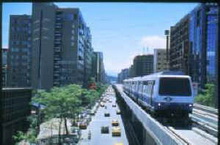
Background
Since 1996, routes of Mass Rapid Transit Systems on the Taipei Metropolitan Area have continually been completed and opened for traffic to provide convenient and comfortable transportation services. It has effectively improved transportation in the metropolitan area and injected new impetus into urban development. As a result, both Asiaweek in the year 2000 and Newsweek in the year 2001 ranked Taipei as one of the most livable cities in Asia.
The Taipei City Department of Rapid Transit Systems (DORTS) is in charge of building metro systems at the Taipei Metropolitan Area. In 2001, DORTS and five affiliated district project offices passed the ISO9001: Year 2000 International Standard Certification for quality management systems, and on January 29, 2002, attained accreditation from the UKAS certification system. This shows that the quality control on all public works for the Taipei MRT at Taipei Metropolitan Area is complete and up to the level of international standards. Because Taipei MRT is convenient, comfortable, on schedule, significantly reduces commuting time, and shortens distances between spots in the city, it has expanded the living domains of urban residents, transformed the lifestyles of Taipei residents, and significantly improved the living quality of people.
Public Art
On the Taipei MRT, in addition to speed and safety, comfort and aesthetics are also emphasized, and these human concerns have the effect of turning MRT space into a cultural phenomenon. At many stations, public art has been installed to enhance the quality of MRT space. Many forms are used to expand the local context of the stations and encourage a feeling of intimacy with MRT structures among the public.
For example, Taipei City Hall Station on the Nangang line, plays host to a sculpture with the title "Growth." This sculpture aims to symbolize the growth of the city under the direction of Taipei City government. In another example, a mural named "Dawning Sail" at Shuanglian Station on the Tamsui line describes the history of the Shuanglian area, while on the same line, the mosaic collages- "Children's Mosaic Trail" and "The Colorful World of Children," along the outdoor pedestrian mall were produced with the cooperation of students from nearby elementary schools.
Public art sometimes provides more than a visual impact. Some of the artworks actually function as station furniture, such as the "Small Park," one of the "Suite of Hands" series at NTU Hospital Station on the Tamsui line; "Push" in the "Growth" series at Taipei City Hall Station on the Nangang line; and "Heaven, Earth and Man" at Xindian Station on the Xindian line. Some interactive artworks are triggered sound effect by viewers' involvement and increase the hearing variety, such as "Around" at the Kunyang Station on the Nangang line and "Historical City--Stone Pillars' at the Zhongxiao W. Rd. Metro Mall on the Nangang line. "Peep" at Gongguan Station on the Xindian line makes special use of public participation to enrich the change of artworks.
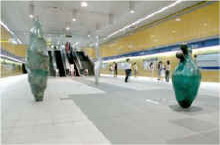
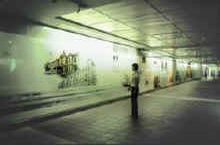
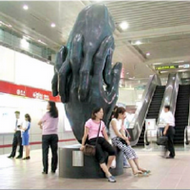
Architectural Design
The form of MRT stations is integrated with their surroundings as circumstances permit. For the Tamsui line, due to expectations that it would become an international window for Taipei, the architecture was designed with Chinese-style image. For the Wenhu line, in order to reduce volume, modern architectural form was used with steel materials and glass in order to convey feelings of technology. On the Zhonghe line, all stations are underground and were designed most economically in accordance with the principle of not allowing ground facilities to impact the urban landscape. Concise design method were employed on the Nangang line in order to reduce the space volume that would impact urban landscape, furthermore, to create new urban landmarks through the selection of public art. The design concept for the Xindian line utilizes simplified pavilion elements that match the environment outside the stations. For the building materials, durability was an early consideration with beauty as the principle. Later economic factors were also taken into consideration.
However, some MRT architecture due to their obvious and unique forms also serve as city landmarks. For example, Jiantan Station on the Tamsui line embodies the attractive qualities of structure with its striking cable system. In addition to being voted one of the city's most impressive landmarks by Taipei citizens, Jiantan Station also won an award from Architect magazine in 1997.
The vent shafts at Zhongxiao Dunhua Station and the multi-function pedestrian mall on the Nangang line were transformed into the public artwork "Tree River." This piece, which provides an eye-catching view of nature in downtown Taipei, came about as the result of a locally performed survey, in which people expressed their preference for an ecological theme.
On the long- term network, furthermore, stations are being designed as works of art in themselves. The particular artistic theme of each station is incorporated in its architectural design. For example, the theme for Sanhe Junior High School Station on the Luzhou line is "Sand." Thus, the station's color will be light brown; the floor will be paved in a sand bar pattern; and the walls will be decorated with graphics of "Egrets Standing on Sand." The goal is to make the environment appear artistic and, at the same time, make art a natural part of the environment.
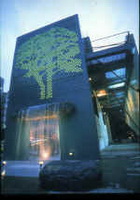
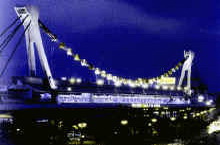
Historic Preservation
Additionally, history is not being ignored in the process of MRT development. When the Nangang line was under construction, great care was taken to preserve the nearby North Gate of old Taipei. During excavation, stone and wooden pillars that previously formed parts of the foundations of the old Taipei City Wall were discovered. They were carefully dug up and restored, and parts of them are now displayed at the location where they were found in the Zhongxiao West Road Underground Mall. Furthermore, some of the stone pillars are reincarnated as elements of art.
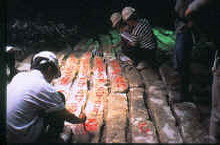
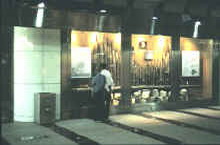
Thoughtful Facilities
Taipei MRT provides the most comfortable and comprehensive environment as possible to serve all kinds of passengers, including tactile and broadcast system for the visually-impaired,information display system and flash signals for the hearing-impaired, ramps and elevators designed for wheelchairs, baby strollers, and the elderly, and diaper changing tables and restroom for parent with toddler for children. Other obstacle-free facilities in rest rooms such as and buzzers and alarms for emergency situations all are thoughtful service. There is also a clear signage system to guide passengers to smoothly ride cars and enter/exit stations. Every effort has been made to offer a full range of services.
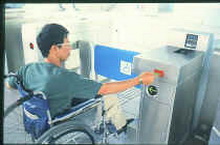
Landscape Planning
The environment along Taipei MRT routes and around the stations provides precious open space for the inhabitants in this crowded city. They walk, exercise, cycle and take advantage of the opportunity for both physical relaxation and mental release. Many open spaces, such as the riverside park outside Tamsui Station on the Tamsui line, are popular tourist destinations during weekends and holidays. These open spaces are for multi- function use.
In addition to combining Chinese architectural characteristics and garden design, the Tamsui line has already become special landscape and places for public activities. Furthermore, the linear parks built along the MRT lines make Taipei bright and dazzling. Consequently, the MRT landscape planning obtained the Ministry of the Interior's 2nd Annual National Excellent Landscape Selection Award.
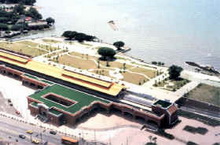
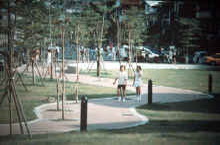
Cultural Events
At some stations, licensed street performers create an artistic atmosphere. MRT trains decorated for promotional purposes also function as a kind of mobile art form. Pathways are used for temporary exhibitions, festivals, concerts are held to encourage use of the MRT system, and it is even possible to watch specially-made TV dramas, for example, "MRT Love Story" on some trains. In short, the MRT enriches the quality of urban life.
An MRT system can have a positive effect on civic pride and people's behavior. When, for example, food and drink are prohibited, the result is a cleaner traveling environment in which people are less likely to litter. Moreover, arrows on platform floors and signs on escalators induce passengers to line up properly and leave pathways clear for others. In this way, people are encouraged to be aware of the convenience of their fellow passengers. Mobile phones must be turned off in certain cars of the train, and there are strict regulations governing the transport of pets. Regular patrols by MRT police are complemented by peer pressure in encouraging the public to obey these regulations and, in some cases, behave differently from when they are outside. In this respect, the MRT has created its own unique culture.

Public Participation
Public participation is carried out in multifaceted ways. For example, a variety of different public briefing sessions are held regularly along with public hearings for the exchange of opinions with the public. Free email access also allows residents to provide timely feedback, and the hosting of station naming activities has increased the publics' feelings of participation. There are also a wide variety of publicity materials, a navigation system, and web pages to obtain public approval while reducing misgivings. In addition, every effort is being made to minimize the impact of construction on local lifestyles and to publicize construction results.
Even for the promotion of public art, attempts are made to invite local people to vote on themes for children's collages, public exhibitions, and public selections. Pictures of the future completed construction projects are also posted on construction fences. Through this variety of different means of public participation, the public nature of the art works is increased and the gap is closed between the public and the art works. A portion of interactive public art even incorporates residents' behaviors into part of the art works, making the appearance of the art works change over time through interactions with different people.
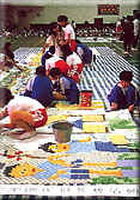
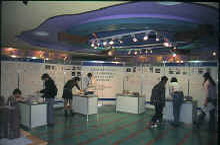
Vision
In addition to the construction projects themselves, Taipei MRT also puts full efforts on public art, architectural design, historical preservation, landscape planning, facilities for the disabled, cultural events and opportunity of interacting with people to enhance the charm of Taipei Metropolitan Area whether at the fields of natural ecology, man-made environment or cultural life.
In conclusion, leisure time nowadays is being emphasized more and more in urban life, and an MRT can play its part in meeting people's needs for more than just transportation. Because it is a vital means for commuters and a key to the city for tourists, aesthetics and comfort should be considered along with the requirements of transportation. Facilities related to human concerns should be incorporated in all future MRT design.
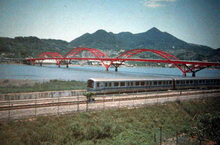
Example Introduction
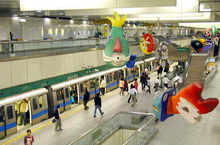
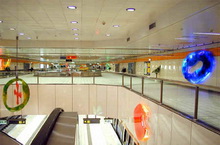
Photo Caption (1):
Public art in the MRT is a pioneer and model for public art in Taiwan.
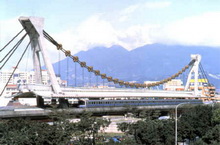
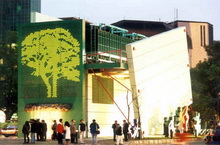
Photo Caption (2):
The MRT architectural works frequently become city landmarks. For example: Jiantan Station on the Tamsui line, and "Tree- River" located on two ventilation shafts in a multi-purpose pedestrian mall and Zhongxiao Dunhua Station on the Nangang line.
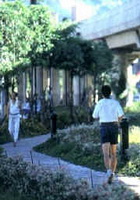
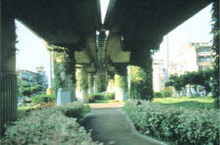

Photo Caption (3):
The MRT landscape planning provides residents with open spaces and green belts that are rarely found in urban areas, including pedestrian areas, linear parks, bicycle paths, and station squares. Consequently,the MRT landscape planning obtained the Ministry of the Interior's 2nd Annual National Excellent Landscape Selection Award.
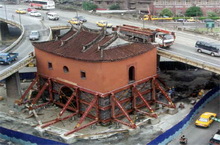
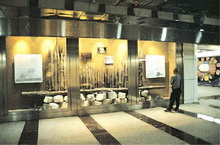
Photo Caption (4):
During the process of establishing the MRT, a great deal of importance was placed on historical preservation. For example: During the construction of the underground tunnel for the Nangang line, the safety of the City Gate was carefully protected. When the rocks and wooden pillars were discovered underneath the Taipei City Wall, they were carefully excavated and stored, and some of the stones were even returned to the location of their discovery to become meaningful historic learning materials.
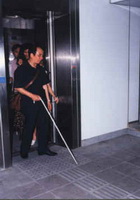
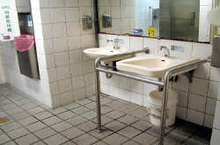
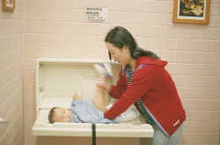
Photo Caption (5):
The Taipei MRT offers as full a range of services as possible in order to meet the needs of all kinds of passengers. (photo credited to TRTC)
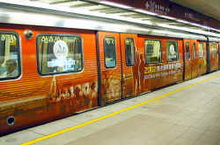
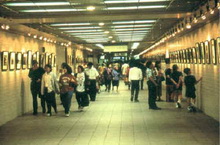
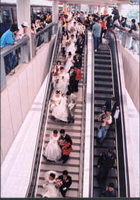
Photo Caption (6):
In terms of cultural events, MRT street performers shape an artistic atmosphere while painted MRT cars, which are used as advocacy tools, have also become moving artworks in the city. MRT facilities are often used for a variety of events, such as temporary exhibitions, festivals, parties, and concerts. These events have created a rich urban lifestyle for Taipei residents with multi- choices for cultural leisure events.

![Taiwan.gov.tw [ open a new window]](/images/egov.png)
